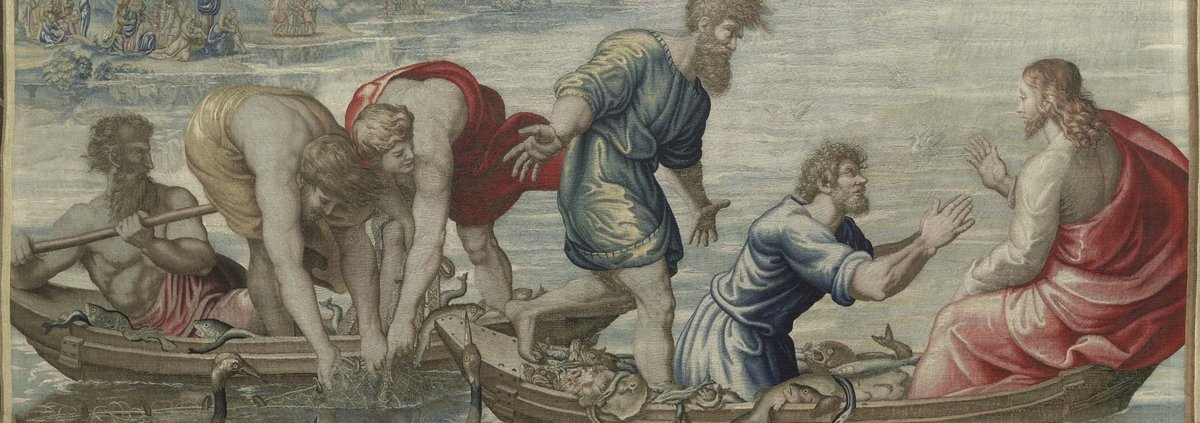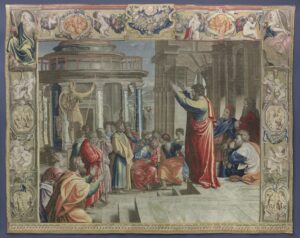From 1515, Raphael (Raffaello Sanzio) was commissioned by Pope Leo X to create ten large-format cartoons; designs which were used in Brussels to weave the tapestries for the Sistine Chapel. Now found in the Vatican Museums, these were hung for the first time at Christmas in 1519. Raphael's cartoons, today in the collection of the Victoria and Albert Museum in London, were purchased in Genoa in 1623 by the future King Charles I of England, who sent them to the Mortlake tapestry workshop for use in weaving further series. The series of six wall hangings which came into the collection of Elector Friedrich August I of Saxony (Augustus the Strong) in 1728 were also made there. Three are dedicated to Saint Peter, the other three to Saint Paul. They depict Bible scenes, such as the Acts of the Apostles by the magician Elymas, who was struck blind when he tried to prevent the governor of Cyprus from believing in the words of the apostles Paul and Barnabas. The exhibition focuses on Raphael's tapestries and designs and their outstanding influence on subsequent artists up to the 19th century through a wealth of examples of their reception.

From 1515, Raphael (

Anthony van Dyck, Charles I of England, c. 1637. Oil on canvas, Staatliche Kunstsammlungen Dresden, Gemäldegalerie Alte Meister, gal. no. 1038.
Mortlake Tapestry Manufactory (after designs by Raphael), The Miraculous Draft of Fishes, After 1625. Tapestry, Staatliche Kunstsammlungen Dresden, Gemäldegalerie Alte Meister, gal. no. B1.
Mortlake Tapestry Manufactory (after designs by Raphael), Feed My Sheep (Christ's Charge to Peter), After 1625. Tapestry, Staatliche Kunstsammlungen Dresden, Gemäldegalerie Alte Meister, gal. no. B2.
[Translate to English:] Freifeld[Translate to English:] text
The Dresden works were woven in England in the 17th century at the noted Mortlake Tapestry manufactory. The production of the tapestries in England is a direct consequence of the acquisition of Raphael’s original cartoons (full-scale Renaissance preparatory drawings for a tapestry) by the Prince of Wales (later Charles I) for the British royal collection in 1623. Charles I subsequently commissioned sets to be woven in the Mortlake manufactory, England’s recently founded tapestry factory located just outside London. The tapestries were brought to Germany in the 18th century by Augustus the Strong (Elector of Saxony and King of Poland). The tapestries were restored in 1991-2003 by Gemäldegalerie Alte Meister and debuted at the opening of the exhibition at GAM in 2020. The Columbus presentation, which was delayed by the pandemic, marks the first time they have ever traveled to the United States.
Mortlake Tapestry Manufactory (after designs by Raphael), St. Paul Preaching at Athens, After 1625. Tapestry. Staatliche Kunstsammlungen Dresden, Gemäldegalerie Alte Meister, gal. no. B5
Commissioned by Pope Leo X, in part to reinforce the authority of the papacy, the tapestries and cartoons from which they are created depict episodes in the lives of Saints Peter and Paul. Raphael’s works consist of monumental figures set against backdrops of landscape or architecture. Considered by many to rank among the greatest paintings ever produced, these masterworks and the tapestries woven from them are renowned for their figures’ magisterial poses, elegant ensemble groupings, harmonious and dynamic compositions, and dramatic narratives presented with remarkable clarity and economy of means. Their importance to European tapestry design was also profound. The tapestries represent a major stylistic shift, from an aesthetic based on flattened space and decorative pattern – medieval in derivation – to the simulation of illusionistic, three-dimensional space populated by towering figures, bringing tapestry design in closer formal alignment with painting. Raphael’s cartoons are represented in the exhibition with two full-scale facsimiles, created specifically for Dresden and Columbus.
In addition to the tapestries, exhibition highlights will include two drawings by Raphael that were studies for his cartoons; works by Renaissance and Baroque masters influenced by the tapestries, such as Albrecht Dürer, Nicolas Poussin and Peter Paul Rubens; 19th-century works that illustrate the tapestries’ continued impact; and portraits of the powerful individuals involved in producing and acquiring the Dresden tapestries, notably Charles I of England and Augustus the Strong.
The exhibition marks the third collaboration between CMA and the Gemäldegalerie Alte Meister. In 1999 CMA presented the exhibition Ages of Splendor and Enlightenment: Eighteenth-Century Paintings from the Old Masters Picture Gallery, consisting of works from the GAM’s permanent collection. In 2018 the GAM lent the Columbus Museum of Art a Venetian masterpiece, which served as the centerpiece of the exhibition Titian’s Lady in White: A Renaissance Mystery. This monographic installation was dedicated to the iconography, restoration, provenance and cultural context of one of Titian’s greatest portraits.




